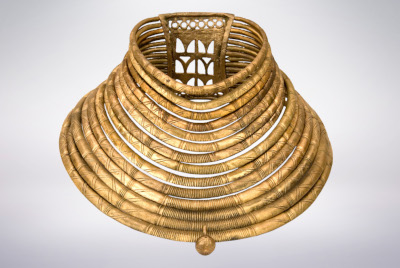Exhibitions
Departments
The exhibition opens with a chronological table and, at the same time, a kind of a table of contents. It features chronological boundaries and names of periods as well as references to the principal development stages of the early civilizations of Europe and the Middle East. The exhibition comprises seven parts, corresponding to the major stages of development of Greater Poland's prehistoric societies. Each epoch has one or more leading themes around which the other parts of the display are organised to present in a condensed form what is most important in a given period. These include e.g. house reconstructions, graves and various constructions (e.g. furnaces or workshops), as well as figural scenes.
The Old Stone Age, the era of hunter and gatherers, is illustrated by a hunter-gatherers' campsite and a group of people performing the most time-engaging activities of that time: hunting and gathering food and the manufacturing of tools needed for these activities. In the Younger Stone Age (Neolithic), when agriculture and animal husbandry became the basis of subsistence, we stress this very important change in the economy and its impact on other aspects of life by showing the reconstruction of permanent settlements with wooden houses, the manufacture of ceramic vessels, weaving and, finally, changes in the funeral rite, manifested by the construction of impressive tombs with earth embankments (barrows) or with stone constructions (megaliths). The main markers of the Bronze Age is - apart from the new raw material - the flourishing material culture and changes in the system of beliefs manifested in the domination of the cremation burial rite, as well as the appearance at the end of this era and the beginning of the next, i.e. the Iron Age - of wooden, fortified settlements, of which the Biskupin stronghold is among the best known. The Iron Age also brought a specific funeral ritual, reflected, among other things, in the presence of graves in the form of stone cairns with vessels placed inside, often decorated with images of the human face (face urns), containing cremated bones of the dead. At that time, we can observe the presence of the Celts in the Polish lands - the peoples who significantly influenced the culture of the then Europe. New inventions arrived (such as the potter's wheel, rotary quern, iron smelting) and the world of religious imaginations changed. In Greater Poland, the rhythm of changes was identical to that in the rest of Poland. The political and cultural expansion of Rome intensified contacts between Central Europe and the Mediterranean, leading to the economic boom of the communities living there. Iron and other metals were smelted on a large scale, new crafts emerged, the material culture became more diverse and sophisticated. The decline of this era, took place in the 5th century AD, with the collapse of the Western Roman Empire and the migrations of "barbarians", leading to the depopulation of Central Europe and its settling by the Slavs. This moment marks the beginning of a new period in the history of Europe - the Middle Ages.
| < |
Paleolithic>> |
Nasza strona internetowa używa plików cookies (tzw. ciasteczka) w celach statystycznych, reklamowych oraz funkcjonalnych. Dzięki nim możemy indywidualnie dostosować stronę do twoich potrzeb. Każdy może zaakceptować pliki cookies albo ma możliwość wyłączenia ich w przeglądarce, dzięki czemu nie będą zbierane żadne informacje. Dowiedz się więcej jak je wyłączyć. OK, Rozumiem


